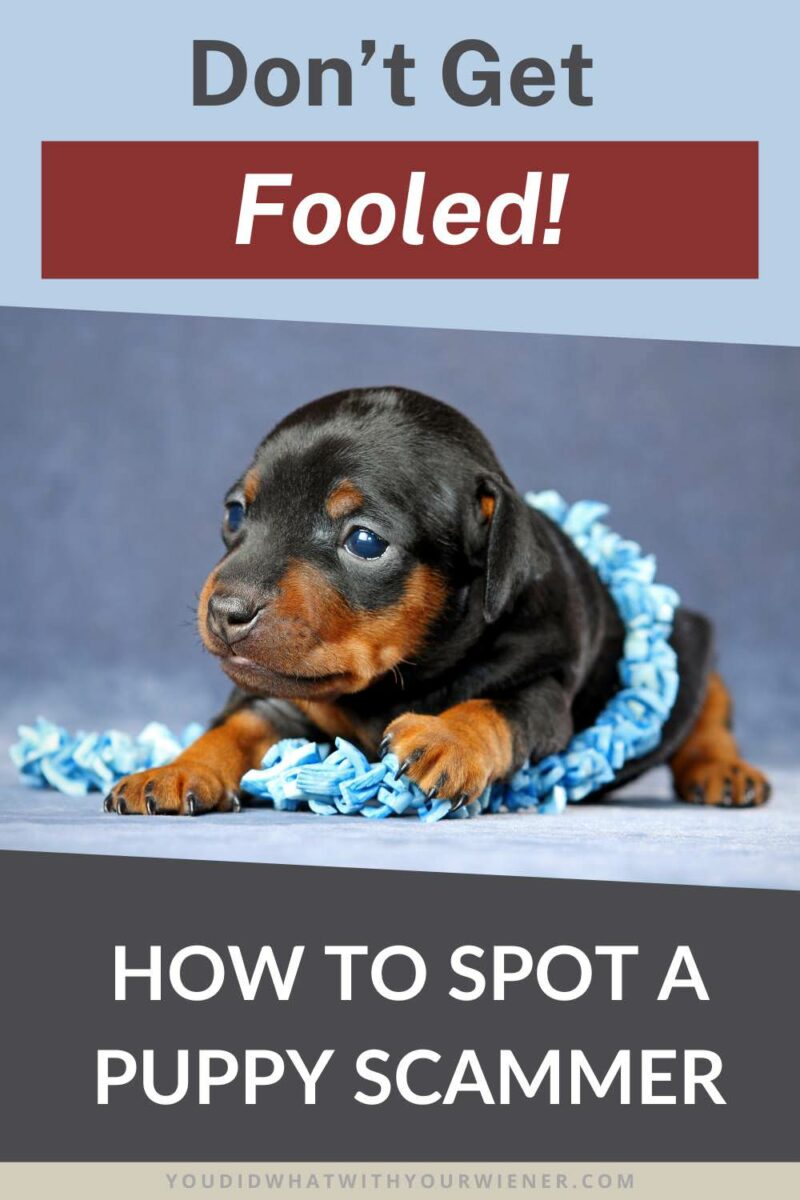Don’t Get Fooled! How to Spot a Puppy Scammer
Whether you are looking for a Dachshund puppy, or another dog breed, puppy scams are everywhere online.
The last thing you want is to get emotionally invested in a new puppy only to have someone take your money and disappear.
I’ve spent years researching responsible dog breeders as well as trying to find the common tricks that puppy scammers use to fool people.

My hope is that the puppy scammer tips in this article will help you avoid the headache of getting your hopes up and duped out of your hard-earned cash.
What Is a Puppy Scam?
A puppy scam is a type of online fraud where scammers pose as legitimate breeders or sellers of puppies, usually purebred or popular dog breeds.
Scammers deceive potential buyers into sending them money for a puppy that either doesn’t exist or will never be delivered.
These scams take advantage of people’s desire to bring a new furry companion into their lives and can be emotionally and financially devastating.
It’s a heartbreaking experience because many potential puppy buyers get personally invested in the puppy they see in pictures.
Many also start buying the needed puppy supplies, and preparing their home to welcome a new furry bundle of joy, only to have the rug pulled out from under them at the last minute.
To help prevent this from happening to you, read the tips below for avoiding a puppy scam.
The Anatomy of a Puppy Scam – How it Works
There are several things that almost all puppy scams have in common.
Below is a description of how most puppy scams work.
Online Ads
Scammers often create attractive online listings or advertisements for puppies on websites, social media platforms, or classified ad sites.
They may use stolen photos of puppies from legitimate breeder’s websites or other sources, like Instagram, to make their ads look convincing.
Fake Identities
Scammers typically create fake identities or personas, claiming to be reputable breeders.
They may use fake names, phone numbers, and email addresses to appear legitimate.
Communication
Interested buyers contact the scammer through the provided information and method, which is often some kind of app like Facebook messenger or WhatsApp.
The scammer usually responds quickly and professionally to inquiries, providing information about the puppy’s breed, health, and price.
They are good at this because natural communication is how they hook you at first.
Payment Request
After gaining the trust of the potential buyer, the scammer will request payment for the puppy.
They may ask for money via wire transfer, money order, or a payment service like PayPal or Venmo.
This money request may be for a deposit or for the full price of the puppy.
Hidden Costs
Once the scammer knows that you have the money and are willing to send it, they will typically contact you for some kind of hidden cost – asking for additional money you didn’t know you would have to pay.
Additional charges are typically shipping fees, insurance, or vaccination costs.
They claim these fees are necessary to send the puppy to you, the buyer.
No Puppy Delivered
Once the payment is made, the scammer may continue to make excuses or delays about shipping the puppy.
In many cases, the puppy is never actually sent, and the scammer cuts off all communication.
Is Buying a Puppy Online Safe?
The first step in a puppy scam is placing a photo of a puppy online to hook you.
Therefore, you may be wondering if buying a puppy online is ever safe.
The answer is sometimes and it depends.
Besides word of mouth, searching online for a puppy is one of the most popular ways to find one.
The problem is that both responsible dog breeders and puppy scammers usually have some kind of online presence.
The key to not getting scammed is being able to spot the legitimate, reputable breeders among the sea of scammers trying to steal your money.
So how do you know the difference?
13 Warning Signs of a Puppy Scammer
Most scams originate on Facebook or Craigslist.
However, some scammers set up websites that look trustworthy to try and trick you into parting with your money.
Scammers know that many people searching for a puppy are desperate, are in a hurry to find one, or are looking for one that is cheap, and will take advantage of that.
Here are some common red flags that may indicate a puppy scam:
1) Puppies ready to go home now
There are definitely times when responsible breeders have puppies available to go home with you right away.
This typically occurs because they are waiting for the right home or someone who was going to buy the puppy backed out.
But if you find a website full of puppies ready to go home right away, it is likely a scam.
2) Too many different colors, patterns, and coat types
Responsible breeders will typically only have one or two litters at a time.
This means that all of the puppies should reasonably come from the same litter.
Red flags include puppies of more than two (three max) colors/patterns or three different coat types (long, short, and wire).
3) Puppies listed are of different ages
As with #2, if a breeder only has one or two litters at a time, all of the puppies should be of the same age, or not that far apart anyway.
For example, puppies that are 8 weeks being shown with several that are 10, 12, and 14 weeks is a red flag.
I will note though that scammers might be getting wise to this tip.
I’ve seen potentially illegitimate websites that list every puppy on the page as being the same age.
Unless it’s a puppy mill or commercial breeder, there won’t be more than about 10 puppies (an average of five if they had two litters) that are the same age.
4) Unrealistically low prices
If the advertised price for a purebred or popular breed puppy seems too good to be true, it probably is.
Scammers often lure victims with below-market prices to attract more buyers.
In my experience, the most common Dachshund puppy scam prices are $650 or $750.
In contrast, a Dachshund puppy from a reputable breeder is typically in the $1,200 to $3,000 range.
Do you research and know what the average price for a puppy of your chosen breed should cost so you can spot the prices that are way off.
5) Lack of location details
A legitimate breeder or seller will provide specific information about their location, including a physical address.
Be suspicious if the seller avoids providing such details or only offers vague information.
6) Poor quality photos
It can be difficult to get good photos of squirmy little puppies so this is not a deal-breaker.
However, a legitimate breeder will keep trying until they get good photos.
Scammers may use low-quality or generic photos of puppies, sometimes taken from other websites or stock image libraries.
Legitimate breeders usually provide multiple high-quality photos of the actual puppies they are selling.
7) Incomplete contact information
Be cautious if the seller’s contact information is incomplete or inconsistent.
Scammers often use disposable email addresses or phone numbers that are difficult to verify.
8) Pressure to act quickly
Like a slimy used car salesman, scammers will often find ways to trick you into making a rushed decision.
They often do this by using high-pressure tactics like claiming there is limited availability or that others are interested in the same puppy.
9) Request for wire transfers
If the seller insists on payment through wire transfers, money orders, or cryptocurrencies, it’s definitely a red flag.
These payment methods are often used by scammers because they are difficult to trace and offer little recourse for the buyer.
Use payment methods like credit cards or PayPal for added security.
10) Hidden or additional fees
Scammers may invent additional fees for shipping, insurance, or vaccinations that were not initially discussed.
Be wary of any unexpected charges.
Reputable breeders are up-front and honest about the cost from the beginning.
11) Poor communication
Pay attention to the quality of communication with the seller.
Poor grammar, misspellings, and overly generic responses can indicate a scam.
Responsible breeders will answer as many questions as you have, and you won’t have to chase them down to find out more about the puppy.
12 Emotional manipulation
Scammers may try to exploit your emotions by sharing heartwarming stories or claiming that the puppy needs a new home urgently.
13) Insistence on shipping
A scammer will likely insist on shipping your puppy even if you live close.
While some responsible breeders will ship puppies, many prefer pick up in person if possible. Some won’t even ship at all.
How to Avoid a Puppy Scam
Unfortunately, people who scam potential puppy buyers become good at deception.
Once potential buyers are wise to their tricks, they change things up and take steps to eliminate or cover up that red flag.
However, there are some common things that can help weed out the scammers from the legitimate breeders.
To avoid falling victim to a puppy scam, consider these precautions:
Check the puppy scammer list
Puppy scams are so common, and have been around long enough, that puppy scammer lists have been created.
While scammers typically change the name once they think they have been found out, it definitely doesn’t hurt to check one of these lists for the breeder name or the name of the person you are communicating with.
Warning though: Many of these sites themselves are clunky and seem spammy.
Here are a few places that you can check that are more legitimate:
- BAD BREEDERS & SCAMMER LIST! Facebook group
- Better Business Bureau
Check to see if the images are stolen
Like I said, many scammers steal images from other places on the internet to lure you in.
You can check for stolen images a couple ways.
Do a reverse Google image search
Following these instructions, search google for the image of the puppy you are considering buying.
While this method is not always foolproof, sometimes the same image can be found in other places.
Unless that other place is associated with the breeder or website displaying the puppy for sale, it’s extremely likely to be a scam.
Check on Instagram
Puppy scammers often steal photos of popular or unique colored Dachshunds from Instagram.
Search Instagram using a few different Dachshund related hashtags and see if the photo of the puppy you want to buy shows up.
Some good hashtags to check are #dachshunds, #dachshundsofinstagram, and any hashtags specific to the Dachshund you’re hoping to buy like #piebaldachshund or #chocolatedapple.
Check references or reviews
Legitimate breeders often have references, reviews, or a web presence on reputable websites.
Scammers may have little to no online presence and lack credible references.
Review the breeders website
A legitimate breeder almost always shows their individual breeding dogs (the Moms and Dads) on their website, often with pedigrees or test results listed.
They will also have a puppy contract and give you access to either the exact form or explain what is in the contract, including health guarantees.
Request real-time access to the puppy
In the past, the recommendation was to visit your chosen breeder in person to view their home and meet the puppy.
Due to privacy reasons, and because outsiders can bring in diseases that can make the puppies very sick, fewer breeders allow in-person visits.
However, a legitimate breeder will still provide some kind of “real time” access like a Zoom or FaceTime meeting.
Scammers may make excuses or refuse such requests.
Ask for specific photos or videos of the puppy
Many scammers just steal photos off the internet to lure in potential puppy buyers.
To help make sure that the puppy actually exists, ask for specific photos or videos.
For example, ask for a video of the breeder showing that the puppy knows the sit command or getting a bath.
For photos, you can ask for different angles of the puppy.
For example, most websites show a puppy’s face but ask for one taken from the rear so you can see the confirmation.
Puppy scammers will almost always be unwilling or unable to provide these.
Most importantly, trust Your instincts
Puppy fever is real and the desire for a puppy can cause one to ignore a red flag or bad gut feeling.
If something seems too good to be true or if the seller is pressuring you to make a quick decision, be wary.
What To Do If You Think You’ve Been Scammed
Unfortunately, most people who fall victim to puppy scammers have no recourse and can’t get their money back.
That’s why it’s important to run as fast as you can if anything at all seems fishy.
However, there are some actions you can take if you suspect you have been scammed.
Try to stop payment
Contact the method of payment you used and see if you can revoke the charges, stop payment, or report the fraud and be reimbursed.
Report the scam to local authorities
Many local police stations have a cybersecurity department where you can report fraudulent transactions initiated or coordinated using the internet.
Start with reaching out to your local police station. If they can’t help you, they may be able to refer you to who can.
Report wire fraud
Wire fraud is a type of fraud that involves the use of some form of telecommunications or the internet.
These can include a phone call, a fax, an email, a text, or social media messaging, among many other forms.
It typically enforced only after money is exchanged but not always the case.
You can report the fraud to the Federal Trade Commission (FTC).
Note: select the “something else” category if none of the others make sense.
You’ll need to provide your personal information and information about the scam itself.
It’s a good idea to add details like the contents of the phishing email, links you clicked, etc.
Warn others
Report the scam to any local dog Facebook groups that may be relevant to warn others in your community.
There are also Facebook groups specifically created for scam reporting, like this Facebook group, where you can share your story.
None of these things guarantee you will get your money back or the person who scammed you will be stopped.
But reporting the crime can make one feel better than just sitting around feeling helpless.
Reporting to all of these places might be too overwhelming, especially if you weren’t scammed out of a lot of money, so just do what feels right for you.
Final Thoughts
If you have found this article, you are either concerned about falling for a puppy scam or you have already been duped and your heart is broken.
Either way, my hope is that these tips on vetting legitimate breeders and avoiding a puppy scammer will help you in the future.
Recovering the funds or identifying the scammer can be extremely difficult, or impossible, so it’s very important to do what you can to avoid a scam in the first place.
If you have been ripped off, I am very sorry. That sucks.
It may be worthwhile to report the crime and try to put a stop on the payment though.


About the Author
Hi, I’m Jessica. I’ve been studying the Dachshund breed since 2007, owned 3 of my own, and shared in the lives of thousands of others through their owner’s stories. When I’m not sharing what I know on this blog, you can find me hiking, camping, and traveling with my adventurous wiener dogs.
